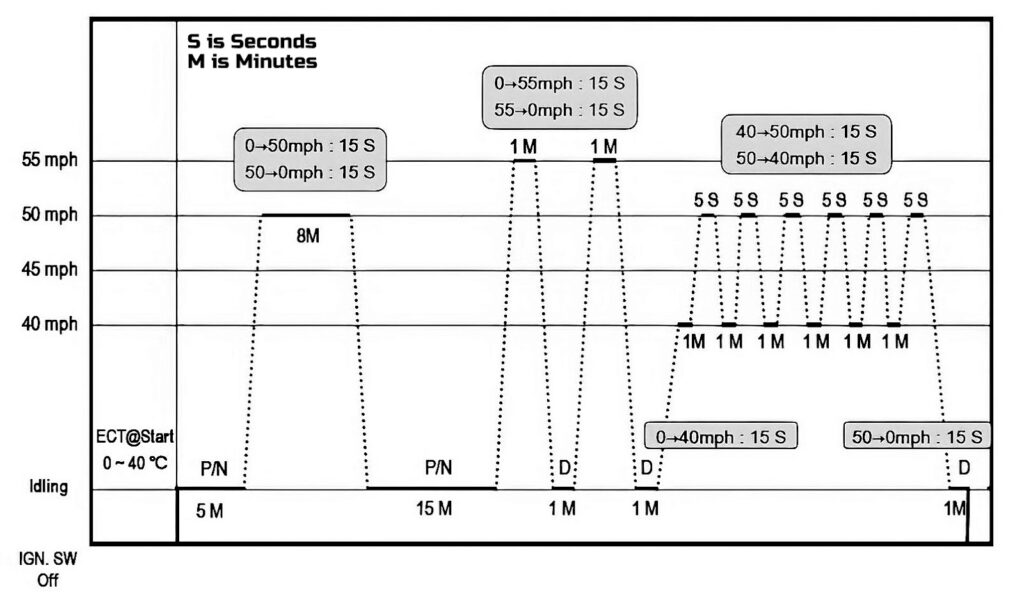As drivers, we’re naturally curious about the performance and overall health of our vehicles. In such cases, we turn to repairs and tests to ensure everything runs smoothly and our ride is in tip-top shape.
For emission system repairs, one of the ways to tell if they’re successful is by taking the vehicle out for a spin and completing a drive cycle.
What is a Drive Cycle?
A drive cycle is one method of testing whether or not emission system repairs are successful. This test requires the vehicle to be driven at specific speeds and times, allowing the powertrain control module to monitor the system and collect data points.
But beyond verifying a repair, during normal driving, the OBD 2 system completes a drive cycle every time certain criteria are met (temperature, speed, distance, etc.). During this cycle, the ECM/PCM runs a series of rationality tests to determine if the emission control devices/systems might be failing.

This information is stored as “Mode 6 Data,” which tracks the upper and lower limits for each data set. When a limit is exceeded in either direction, a DTC will be stored.
Each type of vehicle will have a different set of standard data points. Therefore, you’ll need to check your vehicle’s service information to match the drive cycle conditions set by the manufacturer.
Beyond verifying a repair, during normal driving, the OBD 2 system completes a drive cycle every time certain criteria are met (temperature, speed, distance, etc.).
– Richard McCuistian, ASE Certified Master Automobile Technician
Types of Drive Cycle
There are two types of drive cycles, namely the modal and transient cycles.
Modal Cycle
Modal driving cycles involve driving for long periods at a constant speed.
Transient Cycle
Transient driving cycles involve changes to mimic real-life driving scenarios.
What Type of Drive Cycle Should I Do?
A transient driving cycle is typically used when performing the tests because it mimics real-world driving conditions. Modal, on the other hand, bears little resemblance to what you’re going to experience on the road, as it’s rare to drive for long periods while maintaining a constant speed.
Preparing Your Vehicle
Make sure that your fuel level is between 15% and 85%. It’s essential to have it on this threshold to ensure the EVAP test will even run.
A typical universal drive cycle also requires that the Check Engine Light is off and that no trouble codes are present.
You should also have your vehicle sit for at least eight hours at 68°F to 86°F. This step is needed so that the intake air and engine coolant temperatures match the surrounding air temperature for accurate testing.

How to Perform a Drive Cycle
Performing a drive cycle involves test drives that mimic real-life scenarios, such as making short drives to simulate going to and from work. While driving, the engine computer monitors the emission system to see if it’s working properly.
Step 1: Connect the scan tool while the ignition is off.
Step 2: Start your vehicle. Drive between 20 and 30 mph for 22 minutes. You may let the speed vary within this range.
Step 3: Stop and idle for 40 seconds before slowly accelerating to 55 mph.
Step 4: Keep your throttle steady at 55 mph for 4 minutes.
Step 5: Stop and idle for 30 seconds before accelerating to 30 mph.
Step 6: Keep your speed at 30 mph for 12 minutes.
Step 7: Repeat steps 4 and 5 four times.
Completing the Final Scan
Go to a nearby auto shop to have the mechanics check your readiness monitors, present codes, and pending codes.
If your vehicle passes all the tests, it’s indicative that the repair was successful and your car is ready for emissions inspection and normal driving.
Can I Complete a Drive Cycle Without Driving?

Unfortunately, there’s no way to complete a drive cycle without driving. An alternative would be to use an OBD-II scanner to clear your vehicle’s internal code. However, it’s simply a band-aid solution and not a definitive way to check if emissions repairs were successful.
How Long Does It Take To Complete a Drive Cycle?
If done properly, a drive cycle takes 20 to 30 minutes to complete. If you factor in the eight hours needed to adjust and match the air temperature, that’s eight and a half hours for the entire process.
How Many Drive Cycles Does It Take to Clear Error Codes?
It normally only takes one drive cycle to clear error codes. Some logged codes, however, require five or more cycles before they reset.
How Can I Tell if the Drive Cycle Is Complete?
The only way to tell if a drive cycle is complete is by taking the emission test and seeing if the error codes are gone. If they persist, you’ll have to do another round of drive cycling or more, depending on the codes.
Closing Thoughts
Performing a drive cycle to ensure system repairs are successful is paramount to maintaining your vehicle. Remember to check your vehicle’s specific service information to make sure you’re getting accurate results.
Any information provided on this Website is for informational purposes only and is not intended to replace consultation with a professional mechanic. The accuracy and timeliness of the information may change from the time of publication.
































